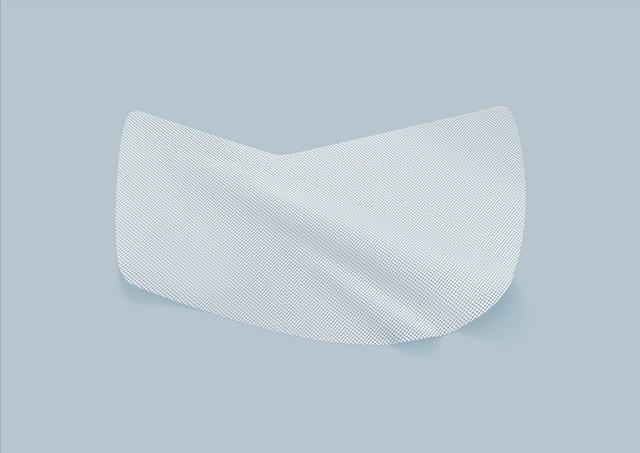TiLOOP® Bra


Benefits
Complete portfolio
The TiLOOP® Bra product family covers all indications for breast surgery with tissue reinforcing material.
- TiLOOP® Bra Pocket: Pre-pectoral reconstruction/augmentation
- TiLOOP® Bra: Sub-pectoral reconstruction/augmentation
Extra light and soft
The TiLOOP® Bra extralight (16 g/m2) introduces the least amount of foreign material into the breast. This light weight material facilitates optimal tissue adaptation, which is of particular importance for the application in the sensitive breast area.
Optimal capsule quality
Compared to simple polypropylene, the hydrophilic and titanised surface carries a reduced risk of inflammation1 and thus a reduced tendency towards the formation of connective tissue-like scars and shrinkage: combined with minimal weight and ides the ideal conditions for a permanent, stable result as well as both desirable tissue ingrowth and a vascularied, flexible, and therefore optimum capsule quality.
Excellent trial-history: proven quality
TiLOOP® Bra has been used in breast surgery since 2008. It has been subjected to numerous trials.
Versatile
TiLOOP® Bra can be used for both primary and secondary breast reconstruction. Further, the use of an expander is also an optional.
[1] Scheidbach et al. In vivo studies comparing the biocompatibility of various polypropylene meshes and their handling properties during endoscopic total extraperitoneal (TEP) patchplasty. Surg Endosc (2004) 18: 211–220
Product Details
- Monofilament fabric
- Non-resorbable
- Atraumatic, laser-cut edges
- EO-sterilised (ethylene oxideEthylene oxide is a gas used as disinfectant for organic insulation (wool, plant fibres), textile fibres, and medical devices and products.), pyrogen free
Technical Data
- Material: Titanised type 1a polypropylene mesh
- Pore size: 1 mm
Knowledge
One of the determining factors for successful breast surgery in the long term, is the correct decision for or against the use of tissue reinforcing material (synthetic mesh or ADM).
TiLOOP® Bra mesh implants* are made of Type 1a polypropylene mesh (macroporous, light & monofilament) with a titanised, hydrophilic surface. Compared to simple polypropylene, this offers a number of advantages:
- lower risk of inflammation1,2,3
- better cell growth4
- less scarring5
- less shrinkage of the mesh1
- less postoperative pain6
- High patient satisfaction and improved quality of life2,3
Practice
TiLOOP® Bra is intended for extension of the pectoralis major, in case of sub-pectoral, implant-based (permanent implant or expander) breast reconstruction. TiLOOP® Bra covers and fixes the caudal pole of the breast implant. The pectoralis major is protected from cranial movement.
*TiLOOP® Bra Netzimplantate sind kein Gewebeersatz.
[1] Scheidbach et al. In vivo studies comparing the biocompatibility of various polypropylene meshes and their handling properties during endoscopic total extraperitoneal (TEP) patchplasty. Surg Endosc (2004) 18: 211–220
[2] Gentile P., et al., Titanium-coated polypropylene mesh as innovative bioactive material in conservatives mastectomies and pre-pectoral breast reconstruction. Bioactive Materials, 2021. 6(12): 4640-4653.
[3] Casella D., et al., Evaluation of prepectoral implant placement and complete coverage with TiLOOP® Bra mesh for breast reconstruction: a prospective study on long-term and patient reported BREAST-Q outcomes, 2019. Plast. Rec. Surg., 143(1):1e-9e
[4] Lehle K., Lohn S. Verbesserung des Langzeitverhaltens von Implantaten und anderen Biomaterialien auf Kunststoffbasis durch plasmaaktivierte Gasphasenabscheidung (PACVD), Abschlussbericht Forschungsverbund “Biomaterialien (FORBIOMAT II)”, 149–173, 2002
[5] Scheidbach et al. Influence of Titanium Coating on the Biocompatibility of a Heavyweight Polypropylene Mesh. Eur Surg Res (2004) 36: 313–317
[6] Sigalove S., et al., Prepectoral Implant-Based Breast Reconstruction: Rationale, Indications, and Preliminary Results, 2017. Plast. Rec. Surg, 139(2):287-294
Application area
- Supporting, strengthening and bridging of body’s own tissue structures, as part of reconstructive and plastic-aesthetic breast surgery.
- Primary breast reconstruction, e.g., after a skin-sparing or nipple-sparing mastectomy
- Secondary breast reconstruction
- Replacement of breast implant
Manufacturer
- pfm medical titanium gmbh, Südwestpark 42, 90449 Nuremberg, Germany
Ordering Information
| Article number | Version | Product weight | Delivery unit (VPE) |
|---|---|---|---|
| 6000636 | small | 16 g/m² | 1 pcs |
| 6000637 | medium | 16 g/m² | 1 pcs |
| 6000638 | large | 16 g/m² | 1 pcs |
| 6000639 | small | 35 g/m² | 1 pcs |
| 6000640 | medium | 35 g/m² | 1 pcs |
| 6000641 | large | 35 g/m² | 1 pcs |
Downloads
- Pre-pektoral Reconstruction with TiLOOP Bra (Casella et al, 2019) | Study Summary (PB4325EN)
- Mesh Implants Breast Surgery | Product Brochure (WPB4300EN)
- Pre-pektoral Reconstruction with TiLOOP Bra (Gentile et al., 2021) | Study Summary (PB4328EN)
- PRO-Bra Study (Thill et al, 2020) | Study Summary (PB4327EN)
- Absorbable Material in Breast Reconstruction | Abstract (PB4324EN)
- TiLOOP Bra (Dietrich et al) | Study Summary (PB4323EN)
- Titanised Meshes Breast Surgery | Scientific Publications (PB4319EN)
- Benefits of Titanisation | Brochure (PB4104EN)
Instructions for use can be found in our Download Center.

Please note:
Not all products are available in every country.
Please refer to the respective country websites:
For all other countries please use the contact form to enquire about availability for your country.